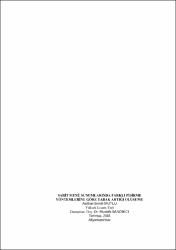| dc.contributor.author | MUTLU Asilhan Semih | |
| dc.date.accessioned | 2018-12-04T08:22:53Z | |
| dc.date.available | 2018-12-04T08:22:53Z | |
| dc.date.issued | 2018 | |
| dc.date.submitted | 2018 | |
| dc.identifier.uri | http://hdl.handle.net/11630/4976 | |
| dc.description.abstract | Dünyada gıda yetersizliğinin artmasına paralel olarak kıtlık yaşayan ülkelerin sayısı da artmaktadır. Kıtlık yaşayan ülkelerin sayılarında artış olmasına rağmen obezite oranlarının yüksek olduğu ülkelerin sayısıda artmaktadır. Obezite sorunu yaşanan ülkelerde gıda israfının tüketim aşamasında olduğu görülmektedir. Bu kapsamda gıda israfında pişirme yöntemlerinin etkisini ölçmek amacıyla toplu beslenme hizmeti veren üniversite yemekhanesinde farklı pişirme yöntemlerine göre tabak artığı oluşumunu incelenmiştir.
Bu kapsamda Afyon Kocatepe Üniversitesi merkez yemekhanede 2017 yılı Nisan ve Mayıs aylarında altı hafta boyunca tabak artıkları gözlemlenmiş ve kayıt altına alınmıştır. Altı haftalık süreçte iki gün resmi tatil olması sebebiyle 28 günlük veri toplanmış ve bu verilerin analizleri yapılmıştır. Kayıt altına alınan veriler betimsel analiz yöntemleri kullanılarak analiz edilmiştir.
Analizler sonucunda sulu ısıda pişirilen yemeklerin kuru ısıda pişirilen yemeklerden daha fazla artık miktarına sahip olduğu, ızgara pişirme yönteminin en az artık miktarına sahip olduğu, aynı tür pişirme yöntemlerinin aynı menüde kullanılmasının artık miktarını artırdığı sonucuna ulaşılmıştır. Böylelikle tabak artık miktarlarının pişirme yöntemlerine göre değişiklik gösterdiği tespit edilmiştir. | en_US |
| dc.description.abstract | In parallel with the increase in food deficiency in the world, the number of countries experiencing famine is increasing. Although there is an increase in the number of countries experiencing famine, the number of countries with high obesity rates is increasing. In countries where obesity is a problem, it is observed that food waste is in the consumption stage. In this context, in order to measure the effect of cooking methods on Food Waste, plate residue formation was investigated in the University cafeteria which provides mass nutrition service according to different cooking methods.
In this context, plate residues were observed and recorded for 6 weeks in April and May of 2017 at Afyon Kocatepe University central cafeteria. Since it was a two-day holiday in the six-week period, 28-day data were collected and analyses of these data were made. The recorded data was analyzed using descriptive analysis methods.
According to result of analysis, cooking by water has more waste than cooking by dry, the grill cooking method had a minimum amount of plate waste, and that the use of the same cooking methods in the same menu had increased the amount of plate waste. Thus, it was determined that the plate waste of the changed according to the cooking methods. | en_US |
| dc.language.iso | tur | en_US |
| dc.publisher | Afyon Kocatepe Üniversitesi Sosyal Bilimler Enstitüsü | en_US |
| dc.rights | info:eu-repo/semantics/openAccess | en_US |
| dc.subject | Yemek Artığı | en_US |
| dc.subject | Tabak Artığı | en_US |
| dc.subject | Pişirme Yöntemleri | en_US |
| dc.title | Sabit Menü Sunumlarında Farklı Pişirme Yöntemlerine Göre Tabak Artığı Oluşumu | en_US |
| dc.title.alternative | Plate Waste Accurance Insorvıng Fıx Menus Accordıng To Dıfferent Cookıng Methods | en_US |
| dc.type | masterThesis | en_US |
| dc.department | Afyon Kocatepe Üniversitesi, Sosyal Bilimler Esntitüsü | en_US |
| dc.relation.publicationcategory | Tez | en_US |



















